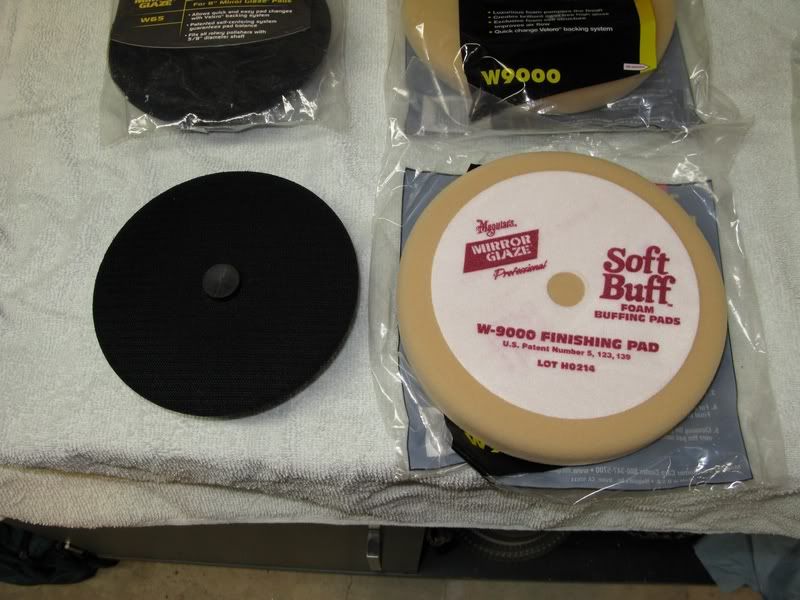... How does this affect foam pad priming such as you've advocated in the past? Isn't that sort of pre-saturating the pad (albeit in a somewhat controlled manner -- except you state that the nature of saturation is an uncontrollable condition) and already breaking the implied new rule before you've even buffed any paint?...
By priming, I mean: To prepare the face of the pad.
By saturation, I mean: Beyond the point that is necessary or desirable.
Funny, but I am just finishing up an article about pad priming, which I should have ready to post by the weekend.
In the meantime, here's a section taken from a paper I was working on (but has been shelved for quite some time):
SATURATION OF THE PAD IS A PERFORMANCE KILLER
While a properly primed pad can help to deliver consistent and optimum performance, a saturated pad can have the opposite effect. For clarification, saturation of the pad’s face and the foam immediately below it is desirable, but an overabundance of polishing liquid permeating the majority of the pad is not.
Saturation of the pad has a direct effect on:
• Pad performance and overall polishing results
• Structural integrity of pads and multi-piece backing plates
• User comfort and machine control
• Premature pad and machine failure
Saturation is a pad and performance killer.
Oftentimes, the negative effects of saturation are not realized until the pad is replaced with a fresh one. Even if a decrease in overall polishing performance is obvious, the user does not usually identify saturation as the responsible culprit. Eventually, the pad becomes unusable or fails altogether. When a pad becomes saturated with liquid, it increases in weight. The extra weight puts additional strain on the buffing pad, backing plate, machine, and user. It also slows the pad’s ability to react to directional changes and surface contours.
Saturation can lead to premature failure of the pad’s attachment system.
Most backing plates and pads use Velcro as their attachment medium. Saturation can delaminate the medium’s bond, especially if it is only glued-based. This can occur rapidly if the polishing liquid contains petroleum based solvents or fillers. As the liquid encroaches and softens the glue, the twisting motion placed upon the pad stresses the attachment. Finally, the added weight increases inertia (intensifying friction-induced heat), and separates the glue from the foam. The backing plate is also susceptible to failure if it is of the multi-piece variety.
Saturation affects resiliency and structural integrity of the pad.
Foam buffing pads are designed to revert to their original shape when subjected to twisting, bending, or compression. This ability is referred to as pad resiliency. Pads are also expected to deliver consistent working characteristics, and last a reasonable amount of time before failure. The structural integrity of the pad is counted on to deliver long lasting performance. Unfortunately, once saturation occurs, moisture permeates the foam, altering structural integrity and pad resiliency (in a negative way).
Normally, air resides in the void areas (or pores) of the foam. Since air is easily compressed and light in weight, it is a critical component of the pad, as it allows the pad structure to mimic spring-action when its shape is distorted. Once the polishing liquid displaces the air, spring-action is diminished because the liquid is much heavier than air and cannot be compressed. The added weight of the liquid overburdens the design parameters of the pad, encumbering the pad’s ability to restore its original shape.
Saturation also affects user comfort and longevity of the machine.
The random-orbital polisher utilizes a counterbalancing mechanism designed to smooth the vibration and rotating inertia of the machine. Most times, the counterbalance cannot adequately compensate for the added weight of a saturated pad, and the user is left to control the excessive movements of the machine. The aggressive movement of the machine can become hard to control, and eventually leads to user fatigue.
If the user applies enough force to steady the machine, the rotating inertia is redirected back onto the machine, and can wreak havoc on bearings and other critical internal parts. As excess heat develops (due to friction or torque-load), it has the ability to shorten the life of the machine. Avoid the onset of pad saturation by cleaning and/or changing the pad often.



